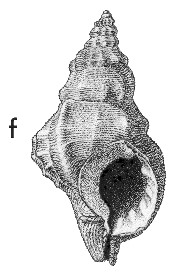
Revised descriptions of New Zealand Cenozoic Mollusca from Beu and Maxwell (1990)

 | Revised descriptions of New Zealand Cenozoic Mollusca from Beu and Maxwell (1990) | 
|
  (Pl. 48f): GS5833, Y14/f7505, Te Piki, Cape Runaway, near East Cape, Haweran (oxygen isotope stage 7, 200 000 years; GNS) |
Beu & Maxwell (1990): Chapter 16; p. 354; pl. 48 f.
Synonymy: Septa parkinsonia Perry 1811, pl. 14, fig. 1; Triton fusiformis Kiener 1842, p. 36; Cymatium parkinsonianum; Austrosassia parkinsoniana; Austrotriton parkinsonia; Sassia (Sassia) parkinsonia, Beu & Maxwell 1990, p. 354, pl. 48f
Type species of Austrosassia Finlay, 1931 (= Sassia Bellardi, 1873)
Classification: Ranellidae: Cymatiinae
Description: Small for genus (35-55 mm high), finely sculptured, with moderately tall spire and short, open, weakly twisted anterior canal. Whorls inflated, evenly rounded except for a weak shoulder angle. Low, rounded varices each 0.67 whorl. Sculpture of narrow, widely spaced spiral cords and low, narrow, widely spaced axial costae, forming low, rounded nodules at their intersections; whole surface closely covered with narrow, finely gemmate spiral threads. Aperture almost circular, with widely flared lips, bearing a parietal tubercle, and 5 low nodules inside the outer lip. Protoconch moderately large, solid, turbiniform, of 3.5 smooth, inflated whorls.
Comparison: The Pliocene (Opoitian-Nukumaruan) species Sassia pusulosa differs from S. parkinsonia in having much more coarsely gemmate sculpture; the Middle-Late Miocene S. pahaoaensis (Clifdenian-Tongaporutuan) has more angled whorls, and higher varices that clasp the previous whorl; the Oligocene-Early Miocene S. maoria (Pl. 20 o) (Duntroonian-Altonian) has coarser spiral cords, more inflated whorls, and a longer anterior canal. These species have in recent years been included in an endemic Australasian "genus" Austrosassia, but there are no significant characters distinguishing them from the very large, cosmopolitan, Late Cretaceous-Recent genus Sassia. European fossil species such as S. formosa (Deshayes) (Eocene, Paris Basin) are extremely similar to S. parkinsonia in size, shape, sculpture (including the many fine surface gemmae), aperture, and protoconch characters.
Distribution: Haweran-Recent; Recent, unlocalised, probably from south-eastern Australia (type of Septa parkinsonia); Recent, "New Holland" (type of Triton fusiformis). Uncommon to moderately common on hard substrates from the intertidal zone (rarely) to outer shelf depths around north-eastern North Island today (particularly at the Poor Knight's Islands); also at the Kermadec Islands, Lord Howe Island, Norfolk Island, and in south-eastern Australia (common intertidally on rocks near Sydney); the single known fossil locality is Te Piki, near East Cape (Haweran, oxygen isotope stage 7) where it is the most common ranellid (about 15 specimens seen).
Cite this publication as: "A.G. Beu and J.I. Raine (2009). Revised
descriptions of New Zealand Cenozoic Mollusca from Beu and Maxwell (1990). GNS
Science miscellaneous series no. 27."
© GNS Science, 2009
ISBN
978-0-478-19705-1
ISSN 1177-2441
(Included with a PDF facsimile file
copy of New Zealand Geological Survey Paleontological Bulletin 58 in CD version
from: Publications Officer, GNS Science, P.O. Box 30368 Lower Hutt, New
Zealand)